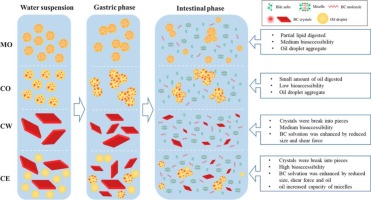当前位置:
X-MOL 学术
›
Food Hydrocoll.
›
论文详情
Our official English website, www.x-mol.net, welcomes your
feedback! (Note: you will need to create a separate account there.)
Effect of Beta-carotene status in Microcapsules on Its in vivo Bioefficacy and in vitro Bioaccessibility
Food Hydrocolloids ( IF 11.0 ) Pub Date : 2020-09-01 , DOI: 10.1016/j.foodhyd.2020.105848 Xiaodong Chen , Rong Liang , Fang Zhong , Wallace H. Yokoyama
Food Hydrocolloids ( IF 11.0 ) Pub Date : 2020-09-01 , DOI: 10.1016/j.foodhyd.2020.105848 Xiaodong Chen , Rong Liang , Fang Zhong , Wallace H. Yokoyama

|
Abstract Sufficient loading capacity and high bioefficacy are both necessary if microencapsulated beta-carotene (BC) is supplemented to overcome Vitamin A deficiency. Four high BC loading (1.2%) microcapsules (BC melted in oil, MO; BC crystals dispersed in oil, CO; BC crystals embedded in wall material, CW; and BC crystals with excipient emulsion, CE) with same wall composition were prepared and their bioefficacy (BE) were compared by in vivo and in vitro tests. BE sequence (CE > CW > MO > CO) from in vivo study was found abnormal, which indicated higher efficacy of crystal BC over melted, excipient oil over oil as solvent. Morphology, particle size and micellization rate change during in vitro GI digestion were investigated to find the reason behind the abnormal. The results suggested that BC molecule could be released from its crystal and included into bile salt micelle with the shear provided by gastric and intestinal movements, the inclusion rate is crystal size dependent; the co-exiting oil would opposite the micellization rate if the oil-BC interaction affected either the diffusion of BC or the digestion of oil. The CE microcapsule had advantages in both factors and therefore resulted in the highest in vivo hepatic VAE, although the possible existence of equilibrium hepatic VAE level (800VAE μg/g liver) led to lower relative BE at excessive BC gavage dosage with effective BC microcapsules. The results from this study challenged the conventional positive concept of encapsulating amorphous BC, provided new insight into the design of effective BC microcapsules.
中文翻译:

微胶囊中 β-胡萝卜素状态对其体内生物功效和体外生物可及性的影响
摘要 如果补充微囊化 β-胡萝卜素 (BC) 以克服维生素 A 缺乏症,则需要足够的负载能力和高生物效率。制备了具有相同壁组成的四种高 BC 负载 (1.2%) 微胶囊(BC 在油中熔化,MO;BC 晶体分散在油中,CO;BC 晶体嵌入壁材料中,CW;以及具有赋形剂乳液的 BC 晶体,CE)并通过体内和体外测试比较了它们的生物功效(BE)。体内研究发现 BE 序列(CE > CW > MO > CO)异常,这表明晶体 BC 比熔化的赋形剂油作为溶剂具有更高的功效。研究了体外 GI 消化过程中的形态、粒径和胶束化率变化,以找出异常背后的原因。结果表明,BC分子可以在胃和肠运动提供的剪切作用下从其晶体中释放出来并包含在胆盐胶束中,包涵率与晶体大小有关;如果油-BC 相互作用影响 BC 的扩散或油的消化,则共存油将与胶束化速率相反。CE 微胶囊在这两个因素上都具有优势,因此导致体内肝脏 VAE 最高,尽管平衡肝脏 VAE 水平(800VAE μg/g 肝脏)的可能存在导致在过量 BC 灌胃剂量下使用有效 BC 微胶囊降低相对 BE。这项研究的结果挑战了封装无定形 BC 的传统积极概念,为有效 BC 微胶囊的设计提供了新的见解。
更新日期:2020-09-01
中文翻译:

微胶囊中 β-胡萝卜素状态对其体内生物功效和体外生物可及性的影响
摘要 如果补充微囊化 β-胡萝卜素 (BC) 以克服维生素 A 缺乏症,则需要足够的负载能力和高生物效率。制备了具有相同壁组成的四种高 BC 负载 (1.2%) 微胶囊(BC 在油中熔化,MO;BC 晶体分散在油中,CO;BC 晶体嵌入壁材料中,CW;以及具有赋形剂乳液的 BC 晶体,CE)并通过体内和体外测试比较了它们的生物功效(BE)。体内研究发现 BE 序列(CE > CW > MO > CO)异常,这表明晶体 BC 比熔化的赋形剂油作为溶剂具有更高的功效。研究了体外 GI 消化过程中的形态、粒径和胶束化率变化,以找出异常背后的原因。结果表明,BC分子可以在胃和肠运动提供的剪切作用下从其晶体中释放出来并包含在胆盐胶束中,包涵率与晶体大小有关;如果油-BC 相互作用影响 BC 的扩散或油的消化,则共存油将与胶束化速率相反。CE 微胶囊在这两个因素上都具有优势,因此导致体内肝脏 VAE 最高,尽管平衡肝脏 VAE 水平(800VAE μg/g 肝脏)的可能存在导致在过量 BC 灌胃剂量下使用有效 BC 微胶囊降低相对 BE。这项研究的结果挑战了封装无定形 BC 的传统积极概念,为有效 BC 微胶囊的设计提供了新的见解。











































 京公网安备 11010802027423号
京公网安备 11010802027423号